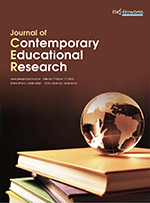Abstract
The formation of self-care ability is the first step for children with autism to enter the society, and it is also a prerequisite and guarantee for their independent survival. This study aimed to explore the impact of visual cue strategies on the self-care ability of children with autism. Based on the ABA design of a single case study, this research conducted a four-month intervention on a seven-year-old child with autism via visual cue strategy as independent variables and sockwearing skills as dependent variables, in order to explore the effect of visual cue strategy on self-care ability of children with autism. It turned out that visual cue strategy exerts a positive immediate sustained effect and social validity on the self-care ability of children with autism. Lastly, suggestions were provided for future related research based on the research process, results, and limitations.
References
Kang H, 2013, Research on the Effectiveness of Video Demonstration Teaching on Learning Self-Care Skills in Children with Autism, dissertation, Chongqing Normal University.
Zhang H, Wei N, Li N, 2016, The Application of Self-Care Flowchart in Improving the Self-Care Ability of Children with Autism. Nursing and Rehabilitation, 15(01): 51–53.
Li X, 2017, Action Study on the Development of Life Care Curriculum for Children with Autism Spectrum Disorders, dissertation, Northwest Normal University.
Ran Y, 2019, Social Work Intervention in Life Skills of Children with Autism, dissertation, Guizhou University.
Zhang Y, 2021, A Study on Improving the Self-Care Ability of Children with Autism by Applying Micro Courses. Education Information Technology, 2021(10): 48–51.
Huang Y, 2021, The Impact of Parental Group Cognitive Behavioral Intervention on Treatment Compliance and Self-Care Ability in Children with Autism. Nursing Practice and Research, 18(22): 3420–3423.
Lu D, Chen J, 2021, The Impact of Family Rehabilitation Training Mode on Self-Care Ability and Social Function of Children with Autism. Grassroots Medical Forum, 25(13): 1918–1919.
Westling DL, Fox L, 2000, Teaching Students with Severe Disabilities, Merrill Publishing, Englewood Cliffs, NJ.
Cao S, Fang J, 2008, “Visual Support” Strategy in Language Intervention for Children with Autism Spectrum. China Special Education, 2008(05): 26–32.
Rao SM, Gagie B, 2006, Learning Through Seeing and Doing. Teaching Exceptional Children, 38(6): 26–33.
Zhang Y, 2017, Research on the Effectiveness of Visual Cue Strategy Based Teaching on Leisure Skills in SchoolAgeChildren with Autism, dissertation, Chongqing Normal University.
Schopler E, 1997, Implementation of TECH Philosophy, John Wiley, New York.
Zhou W, 2019, A Case Study on Improving the Symbolic Play Ability of Preschool Children with Autism Through Visual Cueing Strategies, dissertation, Chongqing Normal University.
Zeng Y, 2002, A Study on the Effect of Visual Cueing Strategies on Self Care Learning of Autistic Students in Elementary Schools, dissertation, Institute of Education, Chiayi University.
Van Laarhoven T, Kraus E, Karpman K, et al., 2010, Comparison of Picture and Video Prompts to Teach Daily Living Skills to Individuals with Originality. Focus on Autism and Other Developmental Disabilities, 25(4): 195–208.
Shrestha A, Anderson A, Moore DW, 2013, Using Point of View Video Modeling and Forward Chaining to Teach a Functional Self-Help Skill to a Child with Autism. Journal of Behavioral Education, 22(2): 157–167.
